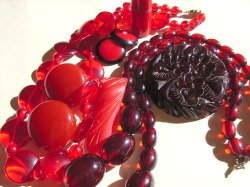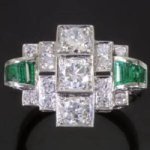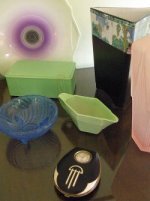Bakelite Test - How to Identify Your Early Plastics
Some links from this site lead to third parties who pay us a commission if you buy something. This allows us to keep providing the information on this site free of charge!
There is no one failsafe Bakelite Test but with a combination of the ways described below, and as you gain experience you will be able to tell pretty confidently whether a piece is Bakelite, Lucite, Celluloid, or one of the other early plastics. (See below for information about these).
Bakelite Test with Simichrome or Formula 409
Many pieces will test with “Simichrome” polish or Formula 409 which turns from pink to yellow on reacting with the chemicals in Bakelite.
However, old wax or polish on the pieces will prevent a positive Bakelite test, as will overdying. Some colours will frequently not react either, such as black and many reds.
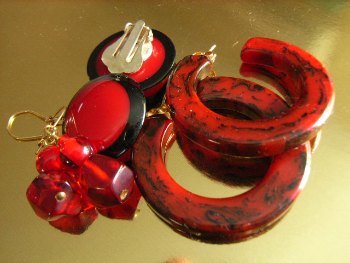 Black and Red Earrings
Black and Red Earrings
Bakelite Test with Hot Water
Immersing a piece in very hot water for 30 seconds or rubbing a piece vigourously with your thumb until it gets really hot will allow Bakelite to give off its characteristic musty phenol odour, which can be useful if you have become experienced in recognising the smell, which has been described as a sickly sweet or resin smell. I notice the smell if I am wearing Bakelite beads on a hot day, after a while if I put the beads to my nose I get a hit of that characteristic odour. Once you know it you can't forget it.
Lucite will not smell, and casein will have a smell of burning milk.
However, some plastics can be damaged by very hot water, so you need to be fairly sure what you are testing is likely to be Bakelite.
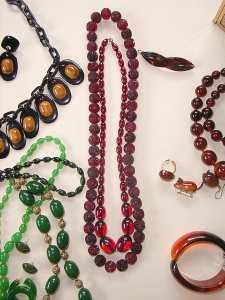 Earthy Colours of Bakelite Jewelry
Earthy Colours of Bakelite JewelryNever test with a hot pin!
Some early plastics such as Celluloid are highly flammable, so you could do yourself and your valuable brooch or necklace some serious damage!
Bakelite Test by Feel and Sound
Bakelite is quite heavy and you will soon get a sense of how it feels. Highly polished pieces feel waxy and slippery, whereas if they have been stripped of their polish pieces can feel slightly abrasive.
Bangles apparently have a deep bamboo type sound when it is clunked together, whereas other plastics sound higher pitched and more brittle, though I find this a difficult one to base a conclusion on personally.
Bakelite Colours and Appearance
Bakelite comes in deep rich colours, from mustard, caramel, reds, oranges and greens, through to tortoiseshell, burgundy and black. Transparent and marbled colours are also common, and "end of day" pieces were made from a mixture of colours mixed together at the end of the day and these can be particularly collectable.
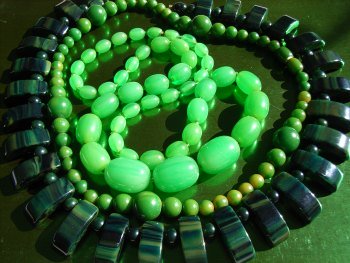 Beautiful Greens
Beautiful Greens
You will NEVER see a White Piece of Bakelite!
The colours tend to darken with age, and for this reason you will never
see a white piece of Bakelite, as it has faded to mustard over the
years. If you cut into a mustard coloured bangle or mahjong tile you
would likely see white inside.
The appearance of certain characteristics will quickly count out items as Bakelite. The biggest one is seams and mould marks. You will not see seams on Bakelite, it would be a real rarity. Finishing methods erased any mould lines.
This leaves Lucite, also rarely with seams and mould
marks, but Lucite is slicker to feel, lighter and has no smell at all.
It comes in bright colors and patterns you would not see in Bakelite,
although there are always exceptions to the norm.
It will never
be worn out looking with whitish wear either. (The exception to this
is with household objects such as canisters and lamps which we call
Bakelite but is different from the stronger material used for
jewellery).
Worn Bakelite jewelry develops what is called patina which enhances the piece as an all over fine scratching which softens the appearance.
Care of your Bakelite jewellery
Store your jewellery away from light and sources of heat. Bakelite may darken or yellow if exposed to light all the time. It can be displayed behind glass or kept in a wooden box. Plastic containers should not be used for storing any early plastics as it can cause crazing. Try not to get perfume on your plastic jewellery as it may dull the finish.
You can polish all your plastics except celluloid with turtle wax or simichrome polish.
Dull pieces which have lost their finish can be brought back to a lovely shine with simichrome polish, which you can buy here.
Fakes
There are many stories of fakes on the market, though I believe some of
these are perpetrated by dealers wanting to offer lower prices for
jewellery by claiming that you have got "Fakelite". These apparently
can pass the chemical tests, but will not produce the characteristic
phenol smell.
My advice is always buy from a trusted seller,
inspect the jewellery carefully and rub hard with your thumb to try and
get the smell. If buying online, always ask the dealer if the piece
has passed the hot water Bakelite test as well as the Formula 409 or
simichrome test.
Be aware also that a lot of jewellery makers
are producing new jewellery out of old rods and sheets of Bakelite.
There is nothing wrong with that, and some of these pieces are real
works of art, so long as they are sold as what they are.
My
opinion is if a piece is beautiful and I will wear it I'm not going to
be heartbroken if a necklace I thought was Bakelite turns out to be
something else. However, if you are buying for investment it pays to be
careful and make sure you are getting what you pay for.
Happy hunting!
Look at my collections of Bakelite Jewelry and learn more
Look at the gorgeous Bakelite Jewelry on Etsy!
Etsy has a surprisingly good range of Art Deco furniture, interior decor, art and prints, 1920s and 1930s fashion, accessories, jewellery and Bakelite. Click the banner to explore.
Join our Facebook Page so you never miss a thing!
Like this Page
- Decolish Home
- Bakelite Test
